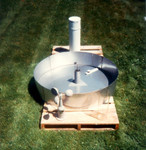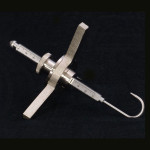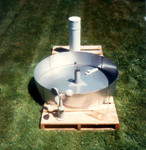 Loading... Please wait...
Loading... Please wait...Hydrological Equipment
- Home
- Meteorological Instruments
- Evaporation Station
- Evaporation Station Accessories
- Stilling Well for Evaporation Station, Fixed Point
The Model 3590 Evaporation Station is a standard U.S. National Weather Service Class A Station used to measure the amount of water lost each day through evaporation.
There are two commonly used procedures for making these measurements. In both, a pan 10 inches deep and 47.5 inches in diameter is used to hold the water. This U.S. Class A pan is normally installed on a wooden platform set on the ground in a grassy location.
First method uses a stillwell with a fixed point. Each time a measurement is taken, the pan is refilled to the level of the point using a calibrated graduate. The graduate has a surface area of 1/100 that of the pan so that the amount of water added is the equivalent evaporation.
Second method for measuring evaporation loss is to use a graduated hook gage set on a stillwell to determine the water level in the pan. The hook gage is adjusted until the point just breaks the water surface, and a reading is taken from the attached scale.
The choice between these alternatives is generally made on a practical basis, such as the availability of daily replacement water.
The amount of evaporation is a function of temperature, humidity, wind and other ambient conditions. In order to relate the evaporation to current or expected conditions, the maximum and minimum temperatures of the water and the amount of air passage are normally recorded along with the evaporation.
A bird guard constructed of wire mesh on a cylindrical frame is used when evaporation measurements may be affected by birds or animals having access to the water in the pan. The Evaporation Station includes evaporation pan, hook gage, stillwell, submersible min/max thermometer, cable and totalizing anemometer and necessary hardware for installation. Specify English or metric units.
Stainless steel with leveling screws. 9”H x 4” diameter.







